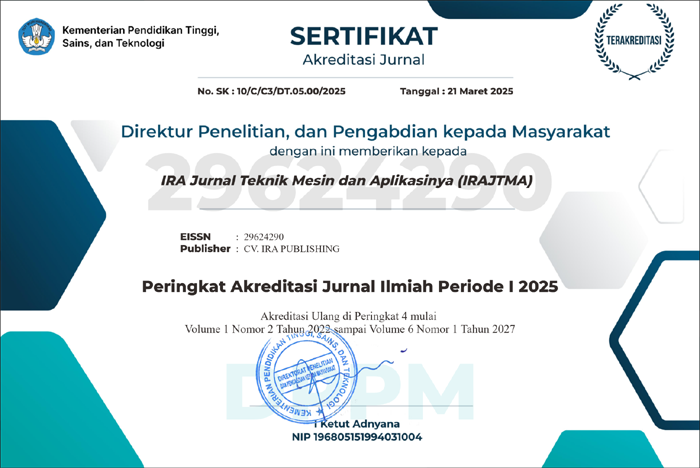Manufacturing Of Biobriqueetes From A Mixture Of Bottom Ash With Young Coconut Solid Waste Using Molasses Adhesive As An Alternative Fuel
DOI:
https://doi.org/10.56862/irajtma.v3i1.39Keywords:
biobriquettes, bottom ash, molasses, organic, and young coconut solid waste.Abstract
Biobriquettes are solid fuels made from compressed organic residues with adhesives. Bottom ash, a byproduct of boiler combustion at PT Blang Ketumba, and young coconut solid waste both have high calorific value and can be utilized as bio briquettes. This study uses a mixture of young coconut waste and molasses adhesive. The research aims to assess the benefits of these materials in bio briquettes, analyze the composition of bottom ash and young coconut waste, and examine the impact of varying ratios of these materials with molasses adhesive. The biobriquette production process involves mixing bottom ash and coconut waste with 2%, 3%, and 4% molasses adhesive in ratios of 100:0, 75:25, 50:50, 25:75, and 0:100. The resulting biobriquettes are evaluated for moisture, ash content, bulk density, combustion rate, and calorific value. The optimal biobriquette, with 25:75 bottom ash to coconut waste and 4% adhesive, showed 7.6% moisture, 5.9% ash, 14.76% volatiles, 71.74% fixed carbon, 1.74 g/cm³ density, 0.32 cal/sec combustion rate, and 5142 cal/g calorific value, meeting SNI 01-6235-2000 standards.
References
Anggoro, D. D., M. H. D. Wibawa, dan M. Z. Fathoni. 2018. "Making Charcoal Briquettes From a Mixture of Coconut Shell and Sengon Wood Sawdust." Technical 38(2): 76. https://doi.org/10.14710/teknik.v38i2.13985.
Arifin, Z., dan W. Nuriana. 2019. "The Calorific Value of Sengon Wood Waste Briquettes with Cornstarch Adhesive Is Higher than Tapioca, Sago and Cassava Flour." Journal of Technology Pillars: Scientific Journal of Engineering Sciences 3(2): 37–41. https://doi.org/10.33319/piltek.v3i2.18.
Haliza, H. N., dan H. Saroso. 2023. "Making Bio-briquettes from Coconut Husk and Teak Sawdust Using Tapioca Flour Adhesive." DISTILLATE: Journal of Separation Technology 8(1): 238–244. https://doi.org/10.33795/distilat.v8i1.308.
Kapita, H., S. Idrus, dan F. Fanumbi. 2021. "Utilization of Coconut Biomass Waste and Corn Cobs for the Manufacture of Briquettes." Journal of SILITEK Engineering 1(01): 9–16. https://doi.org/10.51135/jts.v1i01.2.
Kusmartono, B., A. Situmorang, dan M. Yuniwati. 2021. "Making Briquettes from Coconut Shells (Cocos nucifera) and Wheat Flour." Journal of Technology 14(2): 142–149. https://doi.org/10.34151/jurtek.v14i2.3770.
Mangin, L., dan C. B. Nugroho. 2015. "The Effect of the Drying Temperature of Sawdust Briquettes and Starch on the Pressure Strength." Journal of Integration 7(1): 31–35.
Patabang, D. 2013. "Thermal Characteristics of Meranti Wood Sawn Powder." Mechanical Journal 4(2): 410–415.
Saleh, A., L. Novianty, S. Murni, dan A. Nurrahma. 2017. "Quality Analysis of Wood Sawdust Briquettes with the Addition of Coconut Shells as an Alternative Fuel." Al-Chemistry 5(1): 21–30. https://doi.org/10.24252/al-kimia.v5i1.2845.
Setyawan, B., dan R. Ulfa. 2019. "Quality Analysis of Charcoal Briquettes from Biomass Waste Mixture of Coffee Skin and Coconut Shell with Tapioca Flour Adhesive." Edubiotics: Journal of Educational, Biological and Applied 4(02): 110–120. https://doi.org/10.33503/ebio.v4i02.508.
Triantoro, A., A. Mustofa, dan A. W. Saputri. 2021. "The Study of the Utilization of a Mixture of Coal Bottom Ash with Sawdust and Coconut Shell Charcoal as Biobriquettes Is Reviewed from Quality Parameters." Journal of GEOSAPTA 7(1): 65. https://doi.org/10.20527/jg.v7i1.10235.
Downloads
Published
How to Cite
Issue
Section
License
Copyright (c) 2024 IRA Jurnal Teknik Mesin dan Aplikasinya (IRAJTMA)

This work is licensed under a Creative Commons Attribution-ShareAlike 4.0 International License.

















